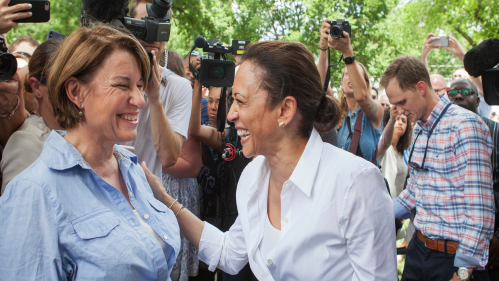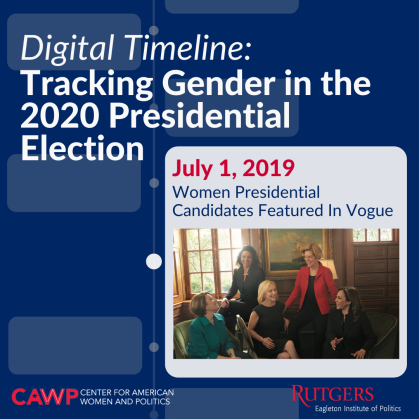New Timeline Illustrates How Gender Shaped Presidential Election

Rutgers scholar notes instances where presidential politics remain influenced by gender and race

How did we go from the most diverse field of presidential candidates in U.S. history to two elderly white men to Joe Biden – a quintessentially traditional politician – winning the election?
Kelly Dittmar, director of research at the Rutgers Center for American Women and Politics, pondered this question as she watched the election unfold last fall.
Key gender-specific events brought us to that critical point, she says.
Dittmar tracked gender’s role in the 2020 presidential election from late 2018 when Elizabeth Warren announced the formation of her exploratory committee to Jan. 20, 2021, when Kamala Harris was sworn in as the nation’s first female vice president.
The results are illustrated in a new timeline titled “Tracking Gender in the 2020 Presidential Election” from the Center for American Women and Politics (CAWP), a unit of the Eagleton Institute of Politics at Rutgers.
The 2020 presidential election made new history for women in the highest echelons of U.S. politics. For the first time, more than one woman competed in a single presidential primary process, with six women running for the Democratic nomination, and Kamala Harris was elected as the first woman and first Black and South Asian vice president of the United States.
But the presence and success of female candidates is just one indicator of how gender shaped the 2020 presidential campaign.
In the case of the primary vote, Dittmar explained, voters questioned the electability of female candidates. Fear about Hillary Clinton’s loss influenced primary votes. Female candidates had extra work on the campaign trail to convince voters they could beat President Donald Trump.
“These moments, archived in the timeline, led us to the primary outcome that was surprising and disappointing to some,” said Dittmar, who is also an associate professor of political science at Rutgers–Camden.
The timeline also looks at how candidates – women and men – navigate campaigns; the ways candidates are perceived, evaluated and treated by voters, media and opponents; and how voters make electoral decisions.
Dittmar says questioning white male dominance was another significant moment during the election cycle.
Throughout the primary election, some questioned whether selecting another white man was a good thing for the country at that moment. White men, she says, hadn’t seen their race and gender as a possible barrier or downside to being an officeholder before.
“This is evidence we're starting to progress,” said Dittmar. “Americans challenged the white male norm in presidential politics. Although President Biden was elected, the media, voters and candidates themselves raised questions about whether we should rethink and readjust our expectations of presidential leadership, so that they are more inclusive of women and people of color.
“Presidential politics remain highly influenced by gender and race and in ways that retain privileges and advantages to white men. If we weren’t already convinced from living the election, the timeline shows that,” said Dittmar. “The archive is meant to be used for people to reflect on 2020 and prepare to watch the 2024 presidential election unfold and see what further progress has been made.”
The multimedia timeline includes embedded videos, graphics and social media content. Users can also sort by tags (such as electability, gender bias, masculinity, white privilege and others). View the full timeline and read Dittmar’s introductory essay here.


